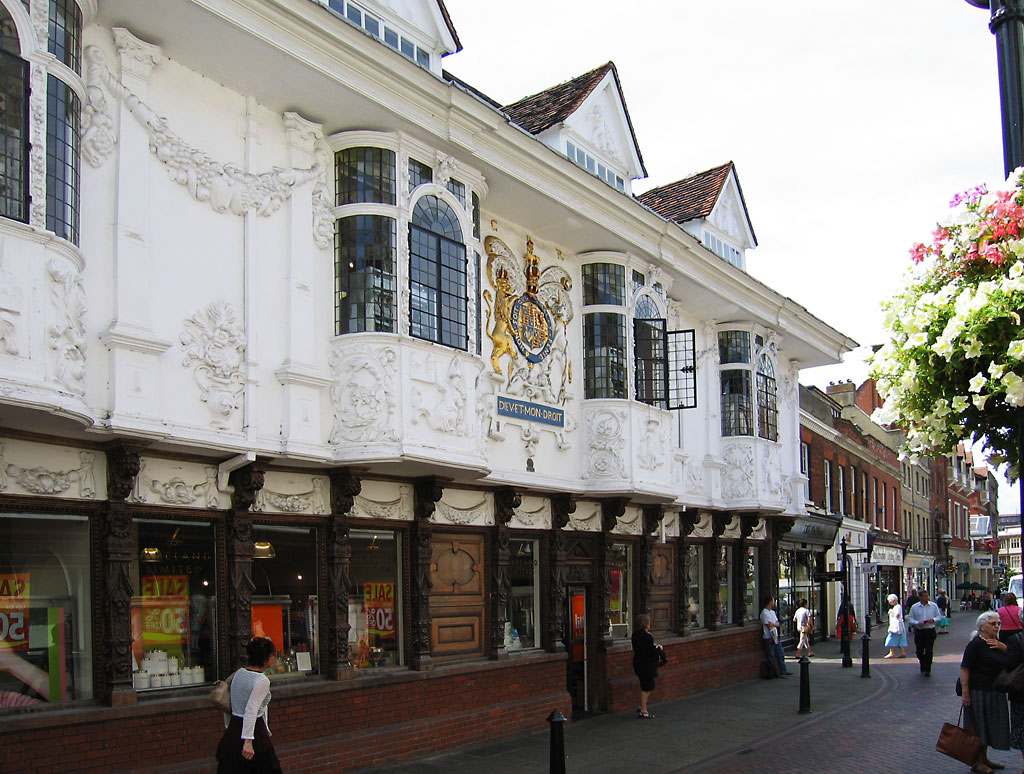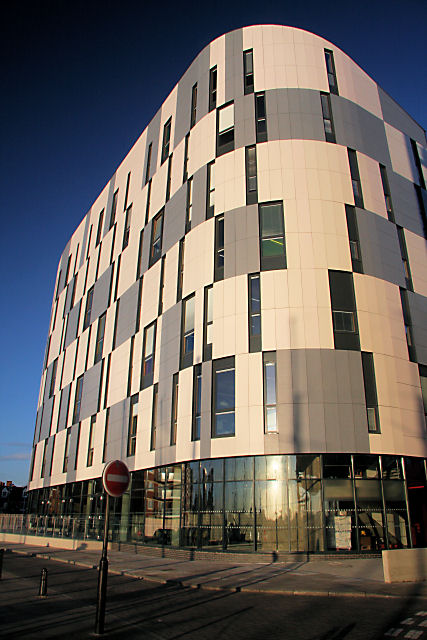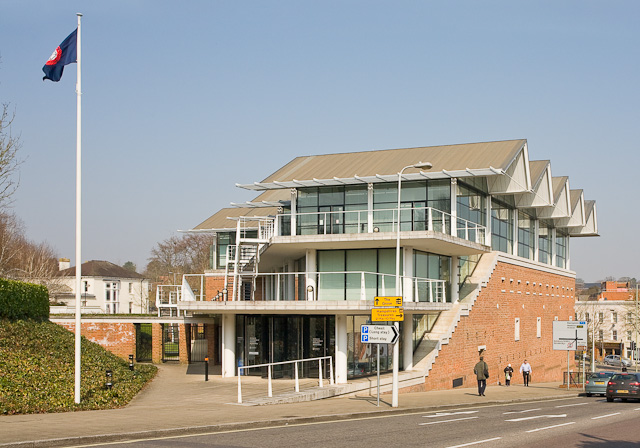|
Suffolk Record Office
Suffolk Archives manage the historical archives for the county of Suffolk. These archives include a wide range of historical council and parish records, plus various commercial records, local historic book collections, local historic newspapers and various personal items. They are accessible to view at three locations: The Hold Ipswich; Lowestoft Library, Lowestoft and Bury St Edmunds. The Hold opened in September 2020 and also hosts various exhibitions, town walks and lectures. This service is run by Suffolk County Council. Suffolk Archives Ipswich Branch Formerly the Ipswich and East Suffolk Record Office, the archives were held in the former Bramford Road School in Gateacre Road. Relocation to The Hold In 2014 Suffolk County Council and the University of Suffolk started working on plans for a collaborative project to create a new premises for a heritage centre close to the University of Suffolk campus on Ipswich Waterfront. By 2018 they had finalised their plans for The Hold, ... [...More Info...] [...Related Items...] OR: [Wikipedia] [Google] [Baidu] |
Suffolk
Suffolk () is a ceremonial county of England in East Anglia. It borders Norfolk to the north, Cambridgeshire to the west and Essex to the south; the North Sea lies to the east. The county town is Ipswich; other important towns include Lowestoft, Bury St Edmunds, Newmarket, and Felixstowe which has one of the largest container ports in Europe. The county is low-lying but can be quite hilly, especially towards the west. It is also known for its extensive farming and has largely arable land with the wetlands of the Broads in the north. The Suffolk Coast & Heaths and Dedham Vale are both nationally designated Areas of Outstanding Natural Beauty. History Administration The Anglo-Saxon settlement of Suffolk, and East Anglia generally, occurred on a large scale, possibly following a period of depopulation by the previous inhabitants, the Romanised descendants of the Iceni. By the fifth century, they had established control of the region. The Anglo-Saxon inhabitant ... [...More Info...] [...Related Items...] OR: [Wikipedia] [Google] [Baidu] |
Ipswich
Ipswich () is a port town and borough in Suffolk, England, of which it is the county town. The town is located in East Anglia about away from the mouth of the River Orwell and the North Sea. Ipswich is both on the Great Eastern Main Line railway and the A12 road; it is north-east of London, east-southeast of Cambridge and south of Norwich. Ipswich is surrounded by two Areas of Outstanding Natural Beauty (AONB): Suffolk Coast and Heaths and Dedham Vale. Ipswich's modern name is derived from the medieval name ''Gippeswic'', probably taken either from an Anglo-Saxon personal name or from an earlier name given to the Orwell Estuary (although possibly unrelated to the name of the River Gipping). It has also been known as ''Gyppewicus'' and ''Yppswyche''. The town has been continuously occupied since the Saxon period, and is contested to be one of the oldest towns in the United Kingdom.Hills, Catherine"England's Oldest Town" Retrieved 2 August 2015. Ipswich was a settlem ... [...More Info...] [...Related Items...] OR: [Wikipedia] [Google] [Baidu] |
Lowestoft
Lowestoft ( ) is a coastal town and civil parish in the East Suffolk district of Suffolk, England.OS Explorer Map OL40: The Broads: (1:25 000) : . As the most easterly UK settlement, it is north-east of London, north-east of Ipswich and south-east of Norwich, and the main town in its district. The estimated population in the built-up area exceeds 70,000. Its development grew with the fishing industry and as a seaside resort with wide sandy beaches. As fishing declined, oil and gas exploitation in the North Sea in the 1960s took over. While these too have declined, Lowestoft is becoming a regional centre of the renewable energy industry. History Some of the earliest signs of settlement in Britain have been found here. Flint tools discovered in the Pakefield cliffs of south Lowestoft in 2005 allow human habitation of the area to be traced back 700,000 years.S. Parfitt et al. (2006'700,000 years old: found in Pakefield', ''British Archaeology'', January/February 2006. Retri ... [...More Info...] [...Related Items...] OR: [Wikipedia] [Google] [Baidu] |
Bury St Edmunds
Bury St Edmunds (), commonly referred to locally as Bury, is a historic market town, market, cathedral town and civil parish in Suffolk, England.OS Explorer map 211: Bury St.Edmunds and Stowmarket Scale: 1:25 000. Publisher:Ordnance Survey – Southampton A2 edition. Publishing Date:2008. Bury St Edmunds Abbey is near the town centre. Bury is the seat of the Diocese of St Edmundsbury and Ipswich of the Church of England, with the episcopal see at St Edmundsbury Cathedral. The town, originally called Beodericsworth, was built on a grid pattern by Abbot Baldwin around 1080. It is known for brewing and malting (Greene King brewery) and for a British Sugar processing factory, where Silver Spoon sugar is produced. The town is the cultural and retail centre for West Suffolk and tourism is a major part of the economy. Etymology The name ''Bury'' is etymologically connected with ''borough'', which has cognates in other Germanic languages such as the German meaning "fortress, castle"; ... [...More Info...] [...Related Items...] OR: [Wikipedia] [Google] [Baidu] |
Suffolk County Council
Suffolk County Council is the administrative authority for the county of Suffolk, England. It is run by 75 elected county councillors representing 63 divisions. It is a member of the East of England Local Government Association. History Established in 1974 and initially based at East Suffolk County Hall, the Council relocated to Endeavour House in Ipswich in 2004. In September 2010, the council announced that it would seek to outsource a number of its services, in an attempt to cut its own budget by 30%. Controversy surrounding the then CEO Andrea Hill, some concerning including £122,000 spent on management consultants, featured in the local and national press in 2011; this led to her facing a disciplinary hearing, and subsequently resigning. Structure of the County Council The County Council is led by its CEO Nicola Beach, who has been in this role since May 2018. The Council is split into 5 distinct areas known as directorates. Each directorate has responsibility for a r ... [...More Info...] [...Related Items...] OR: [Wikipedia] [Google] [Baidu] |
University Of Suffolk
The University of Suffolk is a public university situated in Suffolk and Norfolk, England. The modern university was established in 2007 as University Campus Suffolk (UCS), the institution was founded as a unique collaboration between the University of East Anglia and the University of Essex. The university's current name was adopted after it was granted independence in 2016 by the Privy Council and was awarded university status.University Campus Suffolk , University of Essex. Retrieved 28 September 2012. ''Daily Telegraph'', 21 June 2011. Retrieved 28 September 2012. The University of Suffolk is spread ... [...More Info...] [...Related Items...] OR: [Wikipedia] [Google] [Baidu] |
Heritage Centre
A heritage centre, center, or museum is a public facility – typically a museum, monument, visitor centre, or park – that is primarily dedicated to the presentation of historical and cultural information about a place and its people, and often also including, to some degree, the area's natural history. Heritage centres typically differ from most traditional museums in featuring a high proportion of "hands-on" exhibits and live or lifelike specimens and practical artifacts. Some are open-air museums – heritage parks – devoted to depiction of daily life or occupational activity at a particular time and place, and may feature re-creations of typical buildings of an era. Such sites are often used for experimental archaeology, and as shooting locations for documentaries and historical-fiction films and television. A few are rebuilt archaeological sites, using the excavated foundations of original buildings, some restore historic structures that were not yet lost, whil ... [...More Info...] [...Related Items...] OR: [Wikipedia] [Google] [Baidu] |
Ipswich Waterfront
The Ipswich Waterfront is a cultural and historically significant area surrounding the marina in the town of Ipswich, Suffolk. The modern dock was constructed in 1842 and the area was a functioning dock up until the 1970s. At the time of completion, the dock was known as 'the biggest and most important enclosed dock in the kingdom'. Although the dock as it stands was constructed in 1842, the area was used for trade as far back as the 7th century. The decline of industry in the town resulted in the area being transformed into a trendy area of Ipswich, the waterfront is now characterised by its marina, known as Neptune Marina, as well as its mix of classical and postmodern architecture which includes multiple high-rise apartment buildings, restaurants, bars and cafés. The waterfront is also home to the main campus of the regions university, the University of Suffolk. Early period A dock was in operation in Ipswich on a bend in the River Orwell in the 8th century, and was probab ... [...More Info...] [...Related Items...] OR: [Wikipedia] [Google] [Baidu] |
The Hold
''The'' () is a grammatical article in English, denoting persons or things that are already or about to be mentioned, under discussion, implied or otherwise presumed familiar to listeners, readers, or speakers. It is the definite article in English. ''The'' is the most frequently used word in the English language; studies and analyses of texts have found it to account for seven percent of all printed English-language words. It is derived from gendered articles in Old English which combined in Middle English and now has a single form used with nouns of any gender. The word can be used with both singular and plural nouns, and with a noun that starts with any letter. This is different from many other languages, which have different forms of the definite article for different genders or numbers. Pronunciation In most dialects, "the" is pronounced as (with the voiced dental fricative followed by a schwa) when followed by a consonant sound, and as (homophone of the archaic pron ... [...More Info...] [...Related Items...] OR: [Wikipedia] [Google] [Baidu] |
County Record Office
In the United Kingdom (and particularly in England and Wales) the term county record office usually refers to a local authority repository, also called a county archives. Such repositories employ specialist staff to administer and conserve the historic and the semi-current records of the parent body. They usually also preserve written materials from a great variety of independent local organisations, churches and schools, prominent families and their estates, businesses, solicitors' offices and ordinary private individuals. Archives may have been acquired either through donation or (more generally) by deposit on long-term loan. Local authorities in certain larger cities sometimes administer their own separate city record office, operating along similar lines. Archive repositories are frequently – but by no means exclusively – used by local and family historians for the purposes of original research, since many records can very often have a continuing administrative or legal s ... [...More Info...] [...Related Items...] OR: [Wikipedia] [Google] [Baidu] |
West Suffolk (county)
West Suffolk was an administrative county of England created in 1889 from part of the county of Suffolk. It survived until 1974 when it was rejoined with East Suffolk. Its county town was Bury St Edmunds. Before the introduction of county councils, Suffolk had been divided into eastern and western divisions, each with their own quarter sessions. The western division corresponded to the Liberty of Saint Edmund. This area had been established by Edward the Confessor in 1044 and was a separate jurisdiction under the control of the abbot of Bury St Edmunds Abbey until the dissolution of the monasteries. This history was reflected in the coat of arms of the county council. The council initially adopted the attributed arms of Edward the Confessor: a cross patonce between five martlets. When the council received an official grant of arms from the College of Arms in 1959, abbots' mitres and the emblem of St Edmund: crossed arrows through an open crown were added. The motto adop ... [...More Info...] [...Related Items...] OR: [Wikipedia] [Google] [Baidu] |
East Suffolk (county)
East Suffolk, along with West Suffolk, was created in 1888 as an administrative county of England. The administrative county was based on the eastern quarter sessions division of Suffolk. East Suffolk County Council's headquarters were at East Suffolk County Hall in Ipswich. In 1974, most of the county reunified with West Suffolk and the county borough of Ipswich to form the non-metropolitan county of Suffolk. Subdivisions From 1894 the administrative county was divided into municipal boroughs, urban districts and rural districts: *Boroughs: Aldeburgh, Beccles, Eye, Lowestoft, Southwold *Urban districts: Bungay (created 1910), Felixstowe and Walton, (renamed Felixstowe 1914), Halesworth (created 1900), Leiston-cum-Sizewell (created 1895), Oulton Broad (created 1904, abolished 1919), Saxmundham (created 1900), Stowmarket, Woodbridge *Rural districts created in 1894: Blything, Bosmere and Claydon, East Stow, Hartismere, Hoxne, Mutford and Lothingland, Plomesg ... [...More Info...] [...Related Items...] OR: [Wikipedia] [Google] [Baidu] |





.png)

